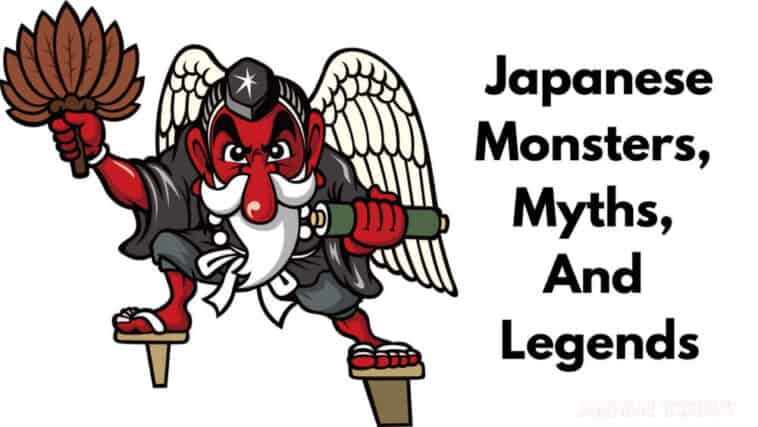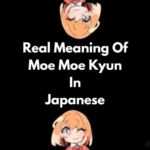Keen to know about Japanese monsters, myths, and legends? Well, you’re in the right place because we’ve brought you the Japanese legends that speak of terrifying and cold-blooded monsters that will send chills down your spine.
Check out the popular Japanese myths below!
Most of us know Japan to be an advanced country that is rich in culture, friendly people with high moral values, tech-savvy equipment, delicious food, and literally one of the safest countries on Earth with a low crime rate.
- Related: All About Oni in Japanese Mythology
- Related: List of Japanese Urban Legends
- Related: List of Japanese Yokai
But not many of us are aware of the elements of Japanese folklore which include multiple myths that can make anyone’s blood run cold. If you’re here to find out about the most intriguing Japanese myths and legends then we’ve some spooky stories for you.

Beware and read at your own risk because it’s going to get really spooky down there!
Page Contents
All About Japanese Monsters, Myths, And Legends
The Okiku Doll – A Real Horror Story
Let’s begin with one of the most terrifying and unsolved Japanese myths of all time that can make you shiver like a leaf in the wind. Dolls are one of the artifacts that evil spirits are fond of and we’re all aware of the horror movies that depict dolls as the main source of evil.
Similarly, there’s a Japanese myth that involves the story of a little girl named Okiku who sadly passed away due to a terminal illness.
Before Okiku passed away she had a doll that was gifted by her brother which looks similar to her and even had the same bob cut hairstyle she had.

After the passing of Okiku, her family began having bizarre experiences with the doll. They witnessed the doll growing hair and having small baby teeth that grew out of the doll’s mouth.
Okiku’s family presumed it was Okiku who possessed the doll and was fascinated to have their daughter back in the form of a doll.
However, Okiku’s atrocities grew stronger and the family decided to offer it to the Mannen-Ji temple where Okiku still resides to this day. The priests at the temple have claimed to cut Okiku’s hair whenever it grows.
If the story of Okiku has intrigued you, you can visit her at the Mannen-Ji temple, however, do so at your own risk because Okiku is known to haunt her visitors in their dreams.
Kitsune – The Mischievous Fox Demon
Kitsune is a Yokai, one of the popular classes of demons in Japanese mythology and Kitsune is Japanese for foxes with paranormal abilities such as shapeshifting, immortality, far eyesight, etc.
In fact, the tail of Kitsune is presumed to grow newly every 100 years. One of the mightiest Kitsune mentioned in Japanese folklore is the nine-tailed fox which is the source of Naruto’s power in the anime.
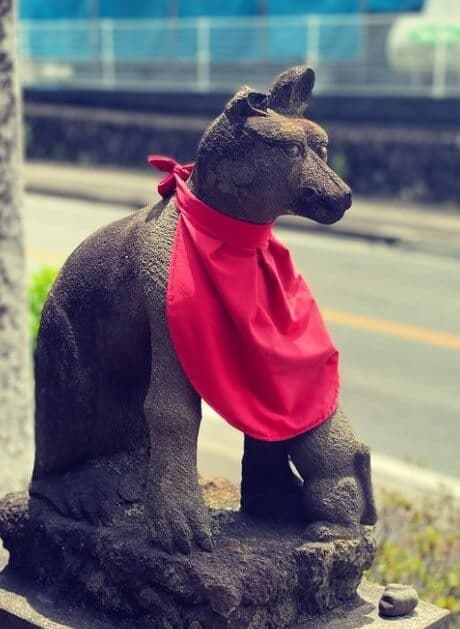
Like most Yokai in Japanese mythology, Kitsune can either be good or evil. The Kitsune foxes that are deemed good are believed to be holy messengers from gods and the protectors of farming fields, and providers of good fortune and prosperity. Even some temples in Japan feature statues of Kitsune.
Meanwhile, there are the evil Kitsune who’s infamous for shapeshifting and playing scary pranks on humans when they travel alone.
Shirime – The Buttock Eye Demon
Shirime is one of my favorite demons in Japanese mythology and I’m very certain the Gen Z’s would love it too. Shirime is also a Yokai which means demons, monsters, or shapeshifters.
However, Shirime is contrary to most Yokai mentioned in Japanese folklore because Shirime has an interesting yet appalling appearance.
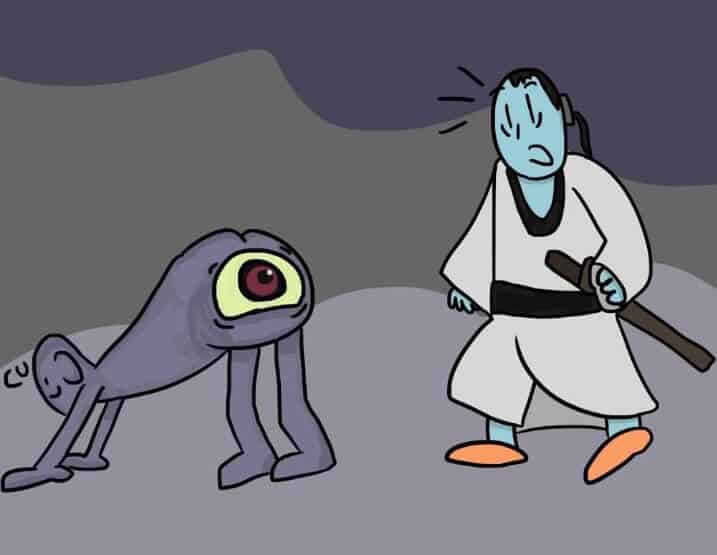
As the name suggests, Shirime is a demon that has a large eyeball on its buttocks. Yes, you read that right, a massive yellowish-white eyeball is on Shirime’s butt which assists Shirime to scare people.
Shirime is believed to be an infamous prankster who loves to scare lonely travelers at night. And Shirime does this by calling out lonely bypassers and bending over to reveal its buttock eye.
This causes the poor witnesses to scream their lungs out and run away in fear. What would you do if you witnessed Shirime in isolated Japanese streets?
The Uninhabited Inunaki Village
Nothing screams scarier than an abandoned place that has a chilling backstory. The Inunaki village in Japan used to be a popular urban myth in the early 90s.
Several people believe that the Inunaki village is situated in Fukuoka Prefecture yet nobody knows the exact location of the village. Some even believe that there is no place called the Inunaki village in Japan.

Despite the availability of the place, the stories that surround the Inunaki village are creepy. The most infamous story which explains the mystery of the Inunaki village is said to be of a couple who had their car break down near the village.
When they were off to look for help they came across a deserted village and they found an old man who promised to help them only to brutally murder them with a sickle.
It’s even believed that the Inunaki village is inhabited by villagers who’re incestual and commit cannibalism.
Although there’s no evidence to prove such claims, it definitely doesn’t sound like a nice place to hang out. Furthermore, no one ever has found the Inunaki village and the question of whether Inunaki village exists is still a mystery.
Kokkuri – The Japanese Ouija Board
Ouija boards are quite the hype among school kids who think it’s all fun and games to summon a spirit. While the regular Ouija boards are speculated to summon human spirits, Japanese legends make mention of a Kokkuri board that summons a demon spirit.
This demon is called “Kokkuri-san” which is a hybrid of a fox, raccoon, and a dog. Kokkuri-san is also said to have three different personalities such as being sly as a fox, bearing good fortune as a raccoon, and being terrifying as a dog.
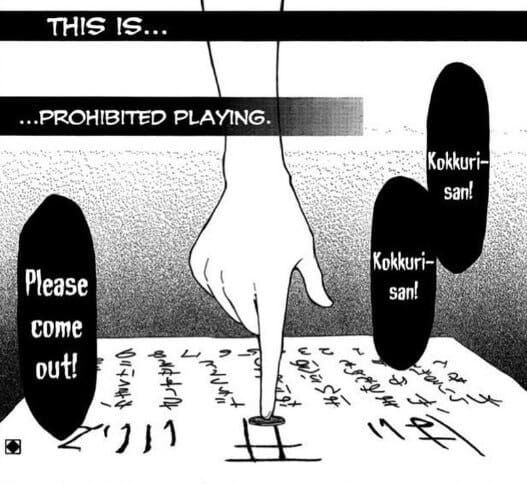
The players can summon the Kokkuri-san by using the Kokkuri board which is made with a bamboo tripod and a little pot.
The players take turns to question Kokkuri-san by placing their hands on the Kokkuri board. Once a question is asked, it’s said that Kokkuri-san will move the pot to answer the question. If the pot remains still then the spirit hasn’t been summoned properly.
Although the Kokkuri board doesn’t sound like a frightening legend, several people link the Kokkuri board to several missing children cases in Japan and even some schools in Japan have banned the students from possessing the Kokkuri board.
Kappa – The Humanoid Reptilian
Japanese mythology is filled with compelling monsters and the Kappa is one of them. Kappa is a yokai that has a human-like appearance yet has a green body with a turtle shell on the back and webbed hands and feet.
The Japanese word Kappa has two kanji letters (河童) which mean “river child”, this is because Kappa is a humanoid amphibian that predominantly inhabits rivers and lakes.
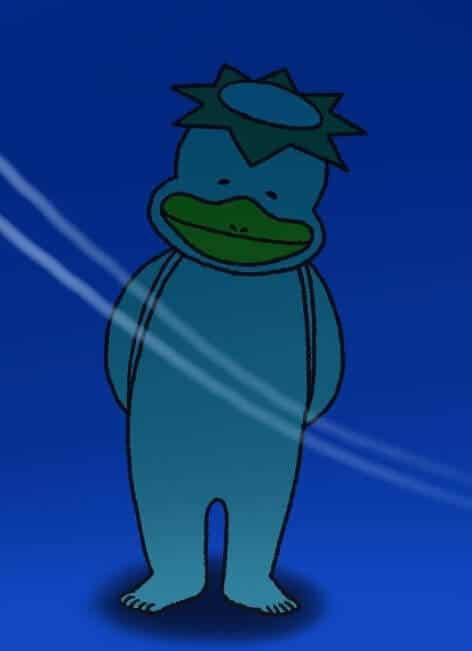
The Japanese believe that the Kappas prefer sumo wrestling and cucumbers. The Kappas are also said to smell like fish due to living underwater and they can even have scaly, slimy skin as well.
One fascinating aspect of the Kappa is that they’re reported to have three anuses which make them pass wind frequently.
Now don’t ask us how we’re aware of Kappa’s anatomy, it’s just what Japanese folklore mentions. Besides, Kappa can be dangerous creatures because they’re speculated to lure humans into the river and drown them after removing their organs from the anus.
Nure Onna – Wet Woman Yokai
Nure Onna is a Japanese yokai you don’t even wanna see in your dreams. Believe me, this demon is so hideous that it can even make you lose your appetite instantly.
“Nure Onna” is Japanese for “wet woman” and this Yokai is a humanoid reptilian that has the body of a snake yet a head of a woman.
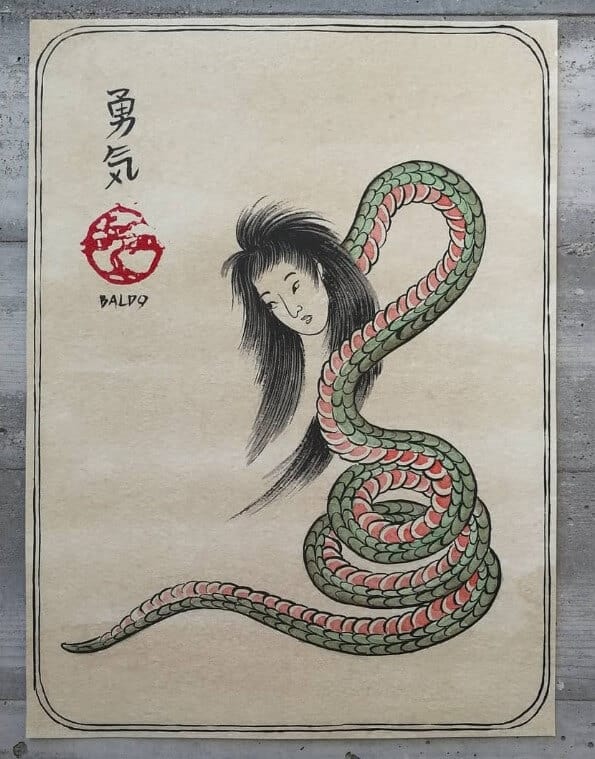
Nure Onna inhabit the seas and rivers in Japan and these monsters have long hair to resemble a woman’s head and their hair is always wet thus the name “wet woman”.
A well-known myth about Nure Onna dates back to the Edo period when a few men were rowing a boat in a river in search of wood.
When rowing they witnessed a woman washing her hair and as soon as they saw her body they screamed and started rowing back.
Nure onna is known to lure people by holding a baby-like bundle and if the victims fall for her tricks she catches them with her snake tail and sucks their blood. Beware of Nure Onna if you happen to visit any rivers in Japan.
Japanese Monsters, Myths, And Legends: FAQs
What are Japanese monsters called?
Japanese mythology includes demons, monsters, ghouls, shapeshifters, etc. These monsters are called Yokai in Japanese and they can either be good or evil depending on their appearance and their modus operandi. Some of the popular monsters in Japanese mythology are Kappa, Shirime, Nure Onna, Kokkuri-san, Kitsune, etc.
What is the most famous monster in Japan?
Japanese mythology and folklore are known to consist of countless demons and monsters. One of the most famous monsters in Japanese mythology is Kitsune which means “the nine-tailed fox” in English. Kitsune is believed to be a Yokai which is Japanese for monster or demon and they can either be holy or evil entities. The holy Kitsune are said to be messengers of god and protectors of fields. Meanwhile, the evil Kitsune are believed to prank and scare people.
What are the popular Japanese myths and legends?
Japanese mythology includes stories of some of the most intriguing and creepy legends in history. Some of the popular Japanese myths and legends are:
Okiku Doll
Kitsune
Shirime – The Buttock Eye Demon
Inunaki Village
Kokkuri Board
Kappa
Nure Onna
Also Read


